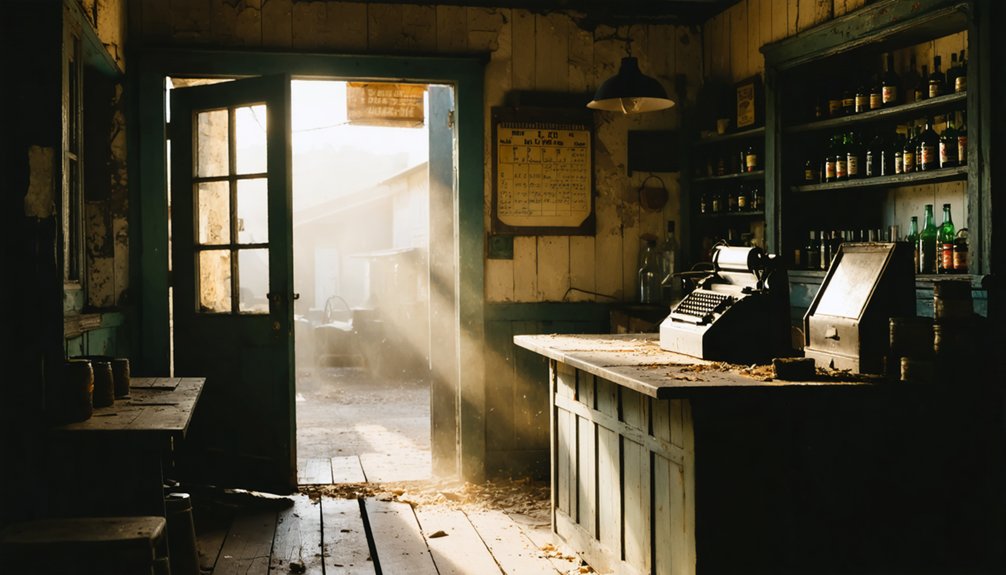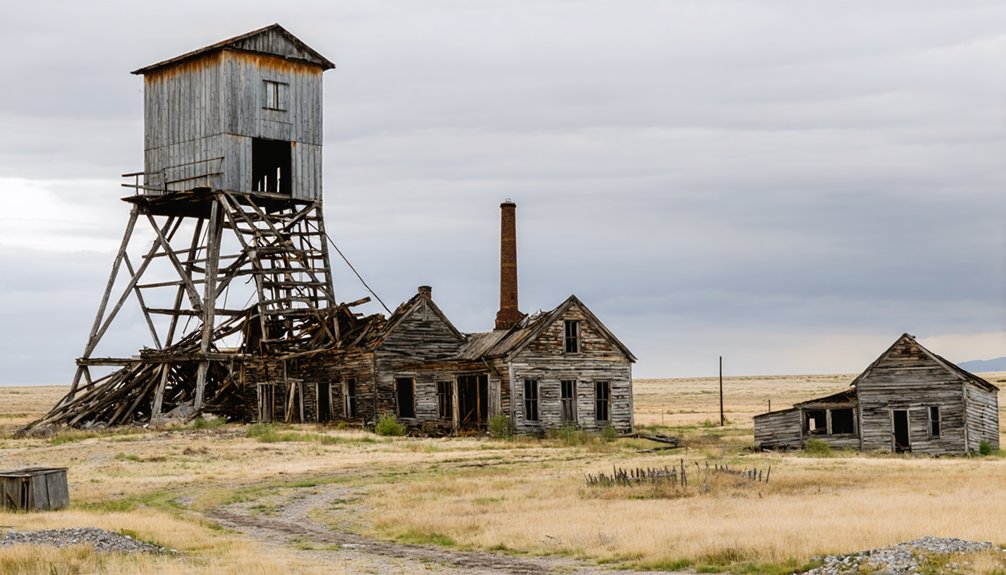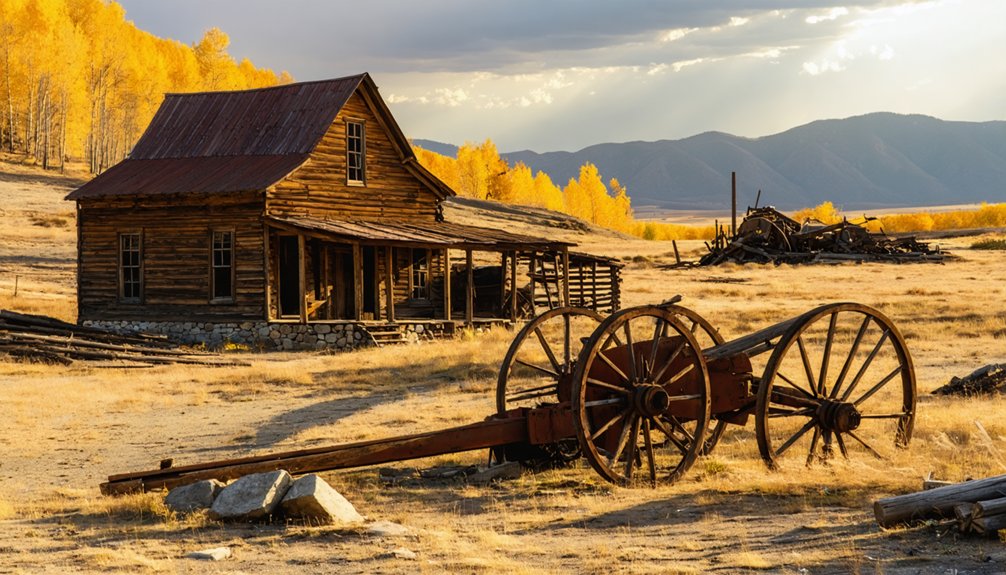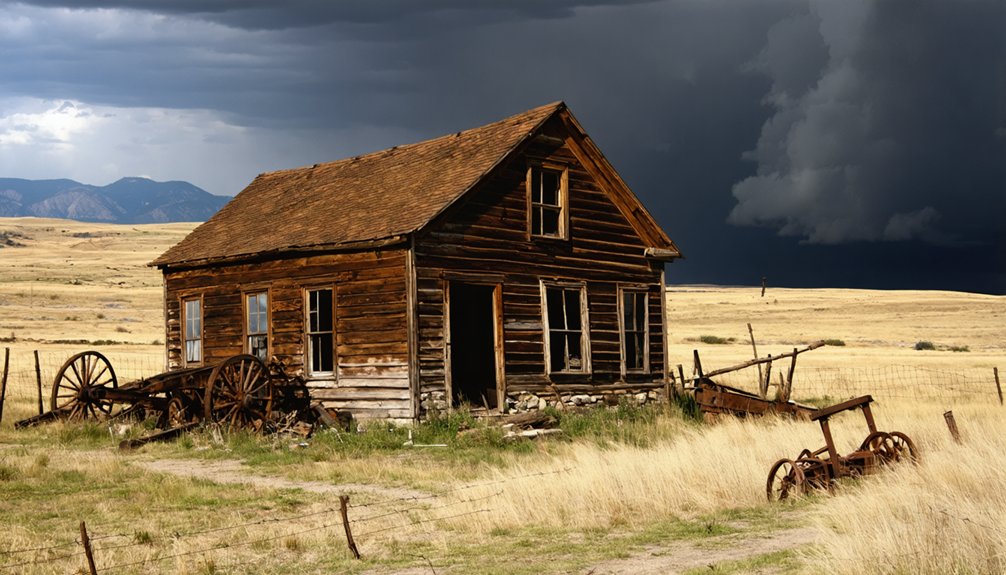You’ll find Addie Camp’s remnants 2.7 miles east of Hill City, South Dakota, where English investors established a tin mining operation in the early 1880s. The settlement thrived around the 800-foot-deep Addie Mine until 1917, complete with a boarding house, saloon, and railroad station. Today, only scattered foundations remain at 4,892 feet elevation, where nature has reclaimed the once-bustling mining community. The site’s forgotten stories echo through the Black Hills’ rugged terrain.
Key Takeaways
- Addie Camp was a mining settlement 2.7 miles east of Hill City, South Dakota, established for tin ore extraction in the 1880s.
- Mining operations reached depths of 800 feet but ultimately failed due to insufficient ore grade and high operational costs.
- The community centered around a boarding house, saloon, train station, and railroad workers’ housing during its peak years.
- Railroad service ended in 1917 with track removal, marking a decisive turning point in the camp’s decline and abandonment.
- Today, only scattered foundations and deteriorating mining remnants remain at the site, with nature reclaiming the former settlement.
The Birth of a Mining Community
When English investors established the Harney Peak Tin Mining, Milling, and Manufacturing Company in the Black Hills, they sparked the creation of Addie Camp in Pennington County, South Dakota.
Located 2.7 miles east of Hill City at an elevation of 4,892 feet, the camp emerged as a hub for cassiterite extraction, with mining techniques reaching depths of 800 feet.
You’ll find that the community dynamics centered around essential structures that supported mining life – a boarding house, saloon, train station, and railroad workers’ car. Like many early fur trading posts, temporary camps often evolved into more permanent settlements.
When the railroad spur arrived in December 1892, it connected Addie Camp to a tin mill east of Hill City, boosting the settlement’s prospects.
The camp’s proximity to the Good Luck Mine, known for tungsten production, created a broader mining district that attracted workers seeking their fortune. Eventually, the mining operation became unprofitable by 1917, leading to the removal of the railroad tracks and the town’s decline.
Life in the Black Hills Mining Camp
Life in Addie Camp revolved around the rhythmic hum of mining operations and railroad activity, with the boarding house and saloon serving as essential gathering spots for weary workers.
Mining’s steady pulse and railroad’s rhythm defined Addie Camp, where tired workers found solace in the boarding house and saloon.
You’d find miners descending up to 800 feet into the earth, extracting cassiterite and tungsten using advanced mining technology of the era, while tramways efficiently connected the mines to processing mills.
The town’s spirit emerged through its bustling railroad station, where standard and narrow-gauge lines transported valuable ore eastward.
Despite harsh Black Hills winters and challenging working conditions, community resilience shone through daily life at 4,892 feet elevation.
You could witness the ebb and flow of workers between the Good Luck Mine and social hubs, creating a tight-knit community bound by their shared mining heritage.
The Addie Mine’s Rise and Operations
The England-based Harney Peak Tin Mining, Milling, and Manufacturing Company established the Addie Mine in Pennington County’s Black Hills during the early 1880s, targeting rich cassiterite deposits at nearly 5,000 feet elevation.
You’ll find this underground operation reached depths of 800 feet through shaft and drift mining, though it never achieved the success its investors hoped for.
While mineral extraction focused primarily on tin ore, the nearby Good Luck Mine also produced tungsten, especially during both World Wars. Much like the Addy Mine in Washington state which began operations in 1916 as a tungsten producer.
The Grand Island & Wyoming Central Railroad’s arrival in 1892 connected the mine to a tin mill east of Hill City, boosting operations.
Extensive development included mining operations on multiple levels, with drifting on four levels from 135 feet to 400 feet deep.
Railroad Development and Transportation
Connecting Addie Camp to regional markets, an essential railroad spur from Hill City arrived in 1892-1893 as part of the Chicago, Burlington and Quincy Railroad system.
You’ll find this crucial transportation link served multiple purposes, extending to Keystone by 1900 and establishing critical mining transportation networks throughout the Black Hills region.
- Railroad logistics supported the movement of cassiterite and tungsten ore from mines reaching 800 feet deep
- Train station facilities included specialized worker cars and boarding houses
- Rail operations enabled efficient transport of mining equipment and personnel
Track removal in June 1917 marked Addie Camp’s changeover from mining to farming.
Today, you can trace this historic route through the Black Hills Central Railroad’s 1880 Train excursions, which preserve the legacy of this once-bustling mining transportation corridor.
The railroad’s challenging terrain required trains to navigate steep grades of 4-6 percent through the mountainous Black Hills landscape.
Daily Life and Social Structure

During your time in Addie Camp, you’d have found miners and their families living in small, basic dwellings clustered near the mining operations at 4,892 feet elevation.
You’d have encountered most single miners staying at boarding houses, where they shared meals and found respite from the harsh weather conditions that included bitter winters and scorching summers.
The saloon owned by Tom Kennedy served as the settlement’s primary gathering spot, where workers socialized after their shifts in the absence of formal institutions like schools or churches.
Living Conditions and Housing
Living conditions in Addie Camp reflected its transient mining identity, with simple wooden structures dotting the landscape near active mines. You’d find two primary housing types: miners’ cabins and boarding houses, with Tom Kennedy’s establishment serving as both saloon and lodging.
Living conditions were particularly harsh, with minimal insulation against brutal winters and scorching summers.
- Shared facilities for cooking and sanitation were common, especially in boarding houses.
- Most residents were single men, with few families settling permanently.
- Basic amenities relied on oil lamps and wood stoves, with no electricity.
- Housing clustered near mine operations, exposing residents to dust and noise.
The remaining buildings along the old Hill City-Keystone gravel road still stand as proof to the utilitarian nature of this mining community’s architecture.
Community Social Activities
Social life in Addie Camp revolved around Tom Kennedy’s saloon and boarding house, which served as the town’s primary gathering hub for miners after their grueling shifts.
You’d find workers congregating there to share meals, gamble, and exchange news about mining prospects. The saloon buzzed with activity during shift changes, filling with tired men seeking entertainment and companionship.
Community gatherings often took place in informal settings, with recreational activities shaped by the town’s rugged conditions and transient population.
You might catch music and dancing events in the boarding house, or join storytelling sessions during harsh winters. The stagecoach’s arrival brought fresh faces and news from neighboring towns, while seasonal celebrations united the community.
Despite the challenging environment, these social connections helped miners cope with the demanding lifestyle of a frontier mining camp.
Environmental Challenges and Mining Struggles
While Addie Camp’s miners pursued valuable tin and tungsten deposits, they faced relentless environmental and operational challenges at their 4,892-foot elevation site in the Black Hills.
You’ll find the environmental impacts were severe – harsh winters and scorching summers battered wooden structures and disrupted mining operations. Limited mining technology of the era couldn’t efficiently extract ore from depths reaching 800 feet, leading to disappointing yields.
- The Addie Mine’s cassiterite deposits proved insufficient despite extensive digging
- The Good Luck Mine’s tungsten extraction struggled with marginal economic viability
- Railroad maintenance costs in the rocky terrain strained resources
- Removal of tracks in 1917 fundamentally sealed the camp’s fate
These combined challenges ultimately overwhelmed the English-owned operation, leading to repeated investment withdrawals and eventual abandonment.
The Decline of Mining Operations

You’ll find that Addie Mine’s decline stemmed from its persistently unprofitable ore extraction, with operational costs exceeding revenues despite reaching depths of 800 feet.
The 1892 railroad spur initially supported mining operations by connecting Addie Camp to the tin mill near Hill City, but the tracks’ removal in 1917 marked a decisive turning point.
The loss of rail transportation severely impacted ore shipments and accelerated the mine’s economic downfall, leading to its eventual abandonment as a commercial venture.
Unprofitable Ore Extraction
Despite significant investment and effort, the Addie Mine‘s cassiterite operations proved financially unsustainable by the early 20th century.
You’ll find that mining profitability challenges stemmed from several critical factors, including the ore’s insufficient grade and the substantial costs of deep extraction reaching 800 feet below ground.
While the English-owned Harney Peak company invested heavily in infrastructure, ore extraction efficiency couldn’t overcome the fundamental economic hurdles.
- Market prices for tin fluctuated unpredictably, undermining stable revenue
- Deep mining operations required expensive equipment and significant labor
- The railroad spur’s construction failed to offset mounting operational losses
- Competition from richer deposits elsewhere made Addie’s operations less viable
These financial struggles ultimately forced the mine’s closure, leading to the removal of railroad tracks by 1917 and Addie Camp’s conversion to a farming community.
Railroad Track Removal Impacts
After the railroad tracks were removed from Addie Camp in June 1917, the mining town’s economic foundations crumbled rapidly.
You’d have witnessed immediate economic disruptions as the crucial rail link to tin mills east of Hill City vanished, leaving miners struggling with costly alternative transport methods.
Without rail access, you couldn’t efficiently move heavy ore shipments or receive essential mining supplies. These transportation challenges made it nearly impossible to maintain profitable operations.
You’d have seen the mining workforce steadily leave as the town’s prospects dimmed. The mines that remained could only operate seasonally, focusing on sporadic wartime demand for tungsten.
Eventually, you’d have watched Addie Camp transform from a bustling mining center into a quiet farming community, following the same fate as many other Black Hills mining towns that lost their railroad lifelines.
Present-Day Remnants and Ghost Town Status
While many Black Hills ghost towns retain some visible structures, Addie Camp’s present-day site features only scattered foundations and deteriorating mining remnants at its 4,892-foot elevation in Pennington County.
Unlike better-preserved Black Hills ghost towns, Addie Camp lies in ruins, marked only by crumbling foundations and mining debris in Pennington County.
You’ll find this abandoned settlement has surrendered to nature since 1917, making it a prime location for ghost town exploration and archaeological findings. Modern visitors can enhance their experience by accessing detailed maps online through Wikiwand’s platform.
- No inhabited buildings remain, classifying it as a “neglected” site
- Natural reclamation has overtaken former settlement areas
- Scattered mining equipment fragments and spoil heaps dot the landscape
- No formal preservation efforts or tourist infrastructure exist
If you’re planning to visit, you’ll need to navigate rural terrain, as there aren’t any marked paths or interpretive signs.
The site stands as a raw indication of the region’s boom-and-bust mining heritage, joining hundreds of other abandoned camps throughout the Black Hills. Like many similar sites, the area has reverted to pasture, with minimal traces of its past civilization remaining.
Historical Legacy in South Dakota

Throughout South Dakota’s Black Hills region, more than 600 ghost towns stand as silent witnesses to the state’s dynamic mining heritage, with each abandoned settlement telling a unique story of ambition, prosperity, and eventual decline.
These remnants serve as powerful touchstones for cultural preservation, offering you glimpses into the lives of frontier families who built schools, churches, and businesses in pursuit of their dreams.
You’ll find that historical tourism has become increasingly significant, as visitors explore these abandoned sites to connect with the past through tangible artifacts and compelling narratives. Many photographers are drawn to these locations for their rustic backdrop and aesthetics. In particular, fine art photographers like Keith Dotson capture the haunting beauty of these decaying structures in black and white images.
The ghost towns’ enduring presence reminds you how economic cycles, transportation changes, and social transformations have shaped South Dakota’s identity, preserving vital lessons about community resilience and adaptation.
Frequently Asked Questions
Were There Any Notable Accidents or Deaths Reported at the Addie Mine?
You won’t find documented evidence of major accidents at Addie Mine in historical records. While mining dangers existed during its 1880s-1910s operation, no specific deaths or accidents were officially reported there.
What Happened to the Mining Equipment After the Camp Was Abandoned?
With 100% of heavy machinery too costly to move, you’ll find most equipment was simply abandoned in 1917. Without railroad access, ghost town preservation efforts reveal equipment was gradually scavenged or left to rust.
Did Any Famous Historical Figures Ever Visit Addie Camp?
You won’t find records of any famous visitors to this remote mining site. Its historical significance centered on industrial operations, not celebrity appearances during its brief 1892-1917 existence.
Were There Any Schools or Churches Established in Addie Camp?
Clear as a bell, you won’t find records of any schools or churches in Addie Camp. The town’s brief history from 1880s-1917 focused on mining, leaving Addie Camp education and religion to nearby communities.
Did Native American Tribes Have Any Interactions With the Mining Camp?
While you’ll find little direct evidence of cultural exchanges or trade relationships with Native Americans at this site, they likely had limited contact after being forcibly removed during the Black Hills War of 1876-1877.
References
- https://kids.kiddle.co/Addie_Camp
- https://www.sdpb.org/rural-life-and-history/2023-08-21/some-black-hills-ghost-towns-and-their-origins
- https://www.sdhspress.com/journal/south-dakota-history-2-2/some-black-hills-ghost-towns-and-their-origins/vol-02-no-2-some-black-hills-ghost-towns-and-their-origins.pdf
- https://www.ghosttowns.com/states/sd/addiecamp.html
- https://en.wikipedia.org/wiki/List_of_ghost_towns_in_South_Dakota
- https://explore.digitalsd.org/digital/collection/WPGhosttown/id/24/
- https://explore.digitalsd.org/digital/collection/WPGhosttown/id/64
- https://www.tripadvisor.com/LocationPhotoDirectLink-g54645-d125429-i71913001-1880_Train_Black_Hills_Central_Railroad-Hill_City_South_Dakota.html
- https://explore.digitalsd.org/digital/collection/WPGhosttown/id/108/
- https://www.whistlehillsoldotna.com/brew602



